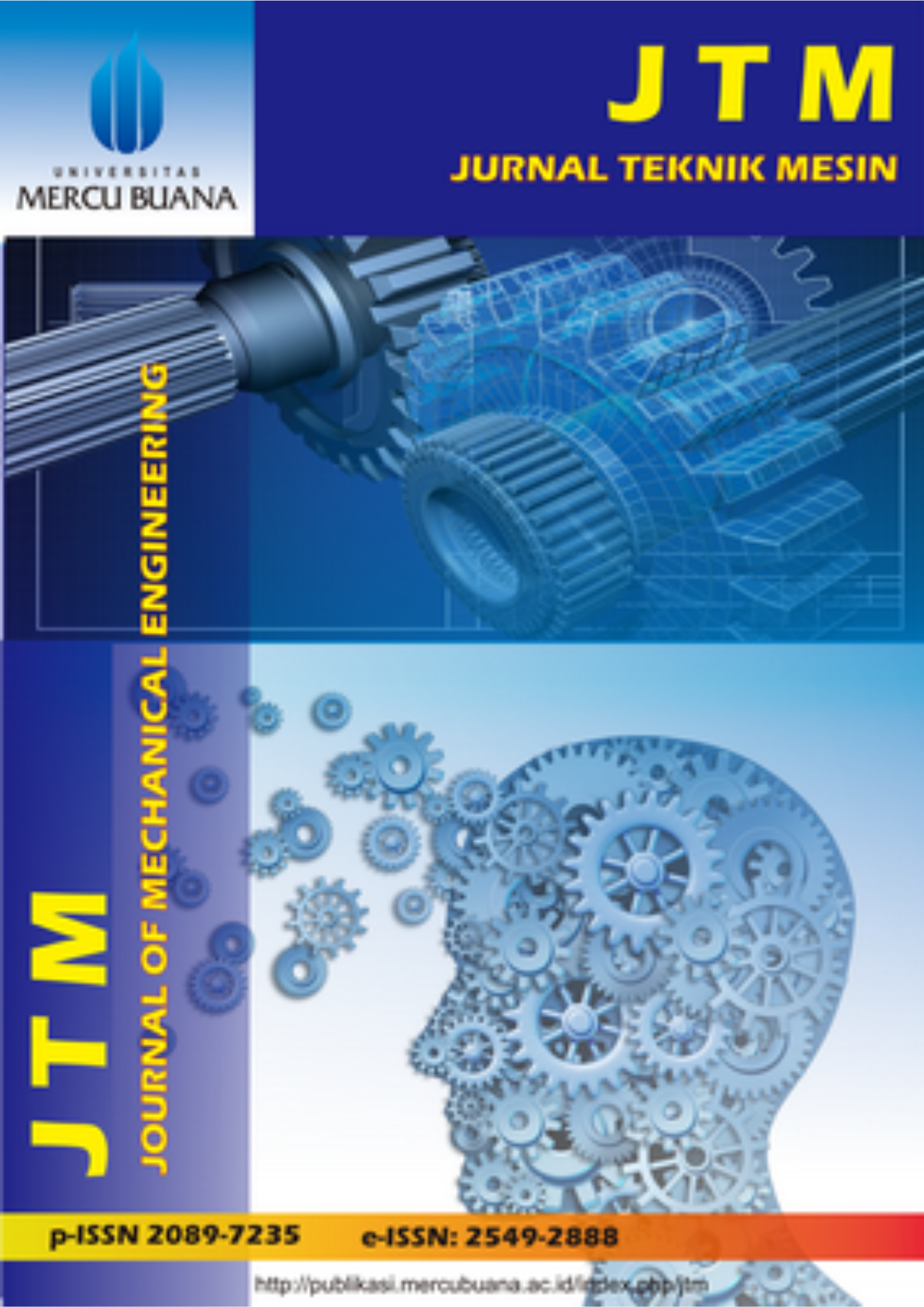PEMBUATAN PARTIKEL SELULOSA MENGGUNAKAN LARUTAN ALKALIN
Abstract
Full Text:
PDFReferences
P. H. Hermans, “Physics and chemistry of cellulose fibers,” Amsterdam,
Y. N. Kuo and J. Hong, "Investigation of solubility of microcrystalline cellulose in aqueous NaOH," Polym. Adv. Technol., vol. 16, pp. 425-427, 2005.
N. Artzi, "Why nanocomposites are in?A glimpse into polymer based nanocomposites," Reviews in Chemical Engineering, vol. 21, pp. 307-345, 2005.
X. M. Dong, J. Revol and D. G. Gray, "Effect of microcrystallite preparation conditions on the formation of colloid crystals of cellulose," Cellulose, vol. 5, pp. 19-32, 03/01. 1998.
A. Isogai and R.H. Atalla,"Dissolution of cellulose in aqueous NaOH solutions," Cellulose, vol. 5, pp. 309-319, 1998.
Y. Kuo and J. Hong, "Investigation of solubility of microcrystalline cellulose in aqueous NaOH," Polym. Adv. Technol., vol. 16, pp. 425-428, 2005.
J. G. Cook, "Handbook of textile fibers.I. Natural fibers," in ,5th ed.Anonymous 993, pp. 10-30.
E. Heuser, The Chemistry of Cellulose. ,3rd ed. New York: Wiley, 1947, pp. 1-40.
S. A. Rydholm, Pulping Process. John Wiley & Sons, 1965, pp. 100-118.
J. W. Ellis and J. Bath, J. Am. Chem. Soc., vol. 62, pp. 2859, 1940.
H. Hatakeyama, T. Hatakeyama and K. Nakamura, "Relationship Between Hydrogen Bonding and Water in Cellulose," Journal of Applied Polymer Science, pp. 979- 992, 1982.
O. Ant-Wuorinen, "The effect on cellulose of swelling solutions of alkaline or neutral character," Tiedotus / Valtion Teknillinen Tutkimuslaitos 60, pp. 30, 1964.
D. Klemm, B. Philipp, T. Heinze and W. Wagenknecht, "Comprehensive cellulose chemistry," in, vol. 1, Anonymous New York: Wiley-VCH, 1998, pp. 10-60.
J. Crawshaw, W. Bras, G. R. Mant and R. E. Cameron, "Simultaneous SAXS and WAXS investigations of changes in native cellulose fiber microstructure on swelling in aqueous sodium hydroxide," J Appl Polym Sci, vol. 83, pp. 1209-1218, 2002.
T. Heinze and A. Koschella, "Solvents applied in the field of cellulose chemistry – a mini review," Polimeros: Ciencia e Tecnologia, vol. 15, pp. 84-89, 2005.
C. Woodings, Regenerated Cellulose Fibres. Cambridge: Woodhead, 2001.
Y. Wang, Y. Zhao and Y. Deng, "Effect of enzymatic treatment on cotton fiber dissolution in NaOH/urea solution at cold temperature," Carbohydrate Polymers, Volume 70, Issue 1,, Pages 8-14, 2007.
M. Inamoto, I. Miyamoto, T. Hongo, M. Iwata and K. Okajima, "Morphological formation of the regenerated cellulose membranes recovered from its cuprammonium solution using various coagulants," Polymer Journal, vol. 28, pp. 507-512, 2003.
L. Zhang, Y. Mao, J. Zhou and J. Cai, "Effects of Coagulation Conditions on the Properties of Regenerated Cellulose Films Prepared in NaOH/Urea Aqueous Solution," Ind. Eng. Chem. Res., vol. 44, pp. 522-529, 2005.
D. Ruan, L. Zhang, Y. Mao, M. Zeng and X. Li, "Microporous membranes prepared from cellulose in NaOH/thiourea aqueous solution," Journal of Membrane Science, vol. 241, pp. 265-274, 10/1. 2004.
R. Evans and P. Luner, "Coagulation of microcrystalline cellulose dispersions," Journal of Colloid and Interface Science, vol. 128, pp. 464-476, 3/15. 1989.
Zeta meter Inc. http://www.mtec.or.th/th/labs/powder/book/coagulation.pdf, "Coagulation and Floccultaion," pp. Retrieved 10.07.2007, 1993.
H. B. Weiser, Colloid Chemistry. ,1st ed.New York: Wiley, 1949, pp. 97-103.
A. Johnson, Colloid Science. ,1st ed.Fair Lawn, N.J.: Oxford University Press, 1950, pp. 202-207.
L. Rahkamo, L. Viikari, J. Buchert, T. Paakkari and T. Suorttidoi, "Enzymatic and alkaline treatments of hardwood dissolving pulp," Cellulose, vol. 5, pp. 79-88, 1998.
G. R. Armando, L. de la Torre, L. A. García-Serrano and A. Aguilar-Elguézabal, "Effect of dialysis treatment on the aggregation state of montmorillonite clay," Journal of Colloid and Interface Science, vol. 274, pp. 550-554, 2004.
R. Nyström, M. Lindén and J. B. Rosenholm, "The Influence of Na+, Ca2+, Ba2+, and La3+ on the ζ Potential and the Yield Stress of Calcite Dispersions," Journal of Colloid and Interface Science, vol. 242, pp. 259-263, 2001.
University of Maryland hompage. Department of Chemical & Biomolecular Engineering http://www.eng.umd.edu/~nsw/ench485/lab4.htm#Objectives, Cellulose degradation, retrieved 01.12.2007.
C.A. King, "Cellulose Fiber-to-Fiber and Fines-to-Fiber Interactions: Their Coagulation and Flocculation Tendencies as Affected by Electrolytes and Polymers in and Agitated Water Slurry, " Ph.D. Thesis, The Institute of Paper Chemistry, 1975, pp. 50-58.
L. Rahkamo, M. Siika-aho, M. Vehviläinen, M. Dolk, L. Viikari, P. Nousiainen and J. Buchert, "Modification of hardwood dissolving pulp with purified trichoderma reesei cellulase”, Cellulose, vol.3, pp. 153- 163, 1996.
F. Fushimi, T. Watanabe, T. Hiyoshi, Y. Yamashita and T. Osakai, "Role of interfacial potential in coagulation of cuprammonium cellulose solution, " Applied Polymer Science, vol.59, issue 1, pp. 15-21, 1995.
M. Vehviläinen and P. Nousiainen, "Improving the solubility of enzyme-treated pulp for cellulosic fibre spinning, " Akzo Nobel Surface’s Seminar: Cellulosic Man-made Fibers in the new Millenium, Sweden, 2000.
M. Vehvilainen, P. Nousiainen, H. Strusczyk and G. East,” Celsol-Biotransformation of cellulose for fibre spinning, Proc. Cellucon International Cellulose Conference, Ellis Horwood Series in Polymer Science and Technology, Wales, 1994.
DOI: http://dx.doi.org/10.22441/jtm.v6i1.1337
Refbacks
- There are currently no refbacks.
Copyright (c) 2017 Jurnal Teknik Mesin
Jurnal Teknik Mesin (JTM)
Program Studi Teknik Mesin, Fakultas Teknik, Universitas Mercu Buana
Jl. Meruya Selatan No. 01, Kembangan, Jakarta Barat 11650, Indonesia
Email: [email protected]
Telp.: 021-5840815/ 021-5840816 (Hunting)
Fax.: 021-5871335
JTM is indexed by the following abstracting and indexing services:

This work is licensed under a Creative Commons Attribution-NonCommercial 4.0 International License.






.png)







_(486_x_90_px)_(486_x_190_px)_(486_x_190_px)_(4).png)
_(486_x_90_px)_(486_x_190_px)_(486_x_190_px)_(5).png)
2.png)
.png)